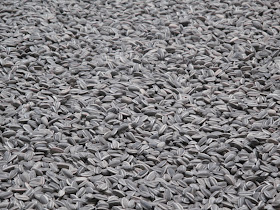The Unilever Series: Ai Weiwei
What do I think? Do I get it? What is the point?
Is what I, as (I guess) many others maybe thinking.
As a piece of art work I don't think much of it, but what it stands for and how it has united a community is perhaps more important than the wanderings of... is this art... & Why? The last image from a video clip, a little blurred - but says it all: ..almost everybody knows someone who is making 'Sunflower Seeds.' I also like that it continues to bring people together beyond the community and allows all walks of life to communicate via video after seeing it.
About the exhibition
Sunflower Seeds is made up of millions of small works, each apparently identical, but actually unique. However realistic they may seem, these life-sized sunflower seed husks are in fact intricately hand-crafted in porcelain.
Each seed has been individually sculpted and painted by specialists working in small-scale workshops in the Chinese city of Jingdezhen. Far from being industrially produced, they are the effort of hundreds of skilled hands. Poured into the interior of the Turbine Hall’s vast industrial space, the 100 million seeds form a seemingly infinite landscape.
Porcelain is almost synonymous with China and, to make this work, Ai Weiwei has manipulated traditional methods of crafting what has historically been one of China’s most prized exports. Sunflower Seeds invites us to look more closely at the ‘Made in China’ phenomenon and the geo-politics of cultural and economic exchange today.
Update: Friday 22 October 2010
The landscape of sunflower seeds can be looked upon from the Turbine Hall bridge, or viewed at close-range in the east end of the Turbine Hall on Level 1. It is no longer possible to walk on the surface of the work, but visitors can walk close to the edges of the sunflower seed landscape on the west and north sides.
Although porcelain is very robust, we have been advised that the interaction of visitors with the sculpture can cause dust which could be damaging to health following repeated inhalation over a long period of time. In consequence, Tate, in consultation with the artist, has decided not to allow members of the public to walk across the sculpture.
Sunflower Seeds is a total work made up of millions of individual pieces which together from a single unique surface. In order to maintain and preserve the landscape as a whole, Tate asks visitors not to touch or remove the sunflower seeds.
Juliet Bingham, Curator, Tate Modern
"Ai Weiwei's Unilever Series commission, Sunflower Seeds, is a beautiful, poignant and thought-provoking sculpture. The thinking behind the work lies in far more than just the idea of walking on it. The precious nature of the material, the effort of production and the narrative and personal content create a powerful commentary on the human condition. Sunflower Seeds is a vast sculpture that visitors can contemplate at close range on Level 1 or look upon from the Turbine Hall bridge above. Each piece is a part of the whole, a commentary on the relationship between the individual and the masses. The work continues to pose challenging questions: What does it mean to be an individual in today's society? Are we insignificant or powerless unless we act together? What do our increasing desires, materialism and number mean for society, the environment and the future?"
Update: Monday 4 April 2011
We understand from news reports that the artist Ai Weiwei was arrested by the Chinese authorities yesterday as he tried to board a plane to Hong Kong. The artist remains uncontactable and his whereabouts are unknown. We are dismayed by developments that again threaten Weiwei's right to speak freely as an artist and hope that he will be released immediately.
We understand from news reports that the artist Ai Weiwei was arrested by the Chinese authorities yesterday as he tried to board a plane to Hong Kong. The artist remains uncontactable and his whereabouts are unknown. We are dismayed by developments that again threaten Weiwei's right to speak freely as an artist and hope that he will be released immediately.
For Ai Weiwei, voicing opinions and communicating with one another is of great importance. From October 2010 to May 2011, visitors to Sunflower Seeds can record a video; either asking him their question or answering one from him. To have a look , follow this link.









No comments:
Post a Comment